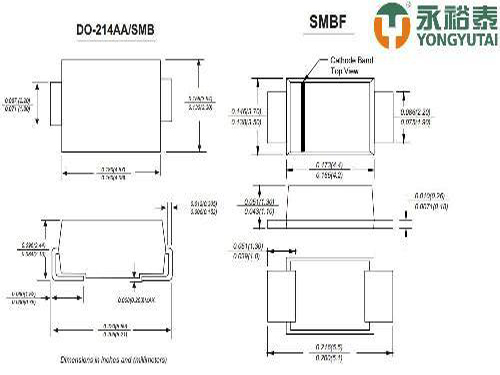Hi, friends, your Yongyutai patch package: SMA, SMB, SMC are the standard specifications? Featured by dome surface, 270 wide lighting beam angle, and side bend. S21 covers all colors and functions as well like S15. Comparing with S15, S21 generates more harmonious lighting effect with lower lumen output.S21can be widely used for garden, landscape, stairs, wall grazing, orientation lighting, window reveal and underground. Neon Light Letters,Custom Led Signs Indoor,Neon Light Signs For Bedroom,Neon Light Board Tes Lighting Co,.Ltd. , https://www.neonflexlight.com
Yes, in terms of appearance, the volume is different: the SMA has the smallest volume, the SMB is wider, and the SMC has the largest volume.
Is there any difference between SMAJ, SMBJ, and SMCJ?
When selecting TVS tubes, in addition to the volume, many electronic engineers will also consider the rated power: SMAJ (rated power 400W), SMBJ (rated power 600W), SMCJ (rated power 1500W).
Transient Suppression Diode Chip Packages SMAJ, SMBJ, SMCJ said the same chip, why split the frame or flat?
For example, as shown in the figure, these two kinds of soldering feet are different: (SMB generally speaking "frame", SMBF generally means "flattening") so it can be used for a variety of different circuit options.
Does TVS use bipolar (ESD) to protect the spike voltage (surge voltage) in both directions of the circuit?
Yes, inrush current refers to the peak current that flows into the power supply device at the instant of power-on. Since the input filter capacitor charges quickly, the peak current is much larger than the steady-state input current. The bidirectional TVS tube has a clamp-limiting function, which is Operating in the reverse breakdown region, due to its advantages of low clamping voltage and quick response, it is particularly suitable for use as the last few protection elements in multi-stage protection circuits.
First, choose what TVS tube to pay attention to, but also to share with us? Of course, then we have a deeper understanding of how to choose the TVS tube, and from the convenience to consider starting it better: First, use the TVS VC value should be lower than the highest voltage protection components. VC is the voltage of the diode in the off state, that is, the voltage through the TVS in the ESD impact state, it can not be greater than the tolerable limit voltage of the circuit being protected, otherwise the device is in danger of being destroyed by electric shock.
Second, TVS should not be in a breakdown state under normal working conditions. It is better to be under VR. Selecting an appropriate TVS should be considered from both VR and VC requirements.
Third, if you know more accurate inrush current IPP, according to the formula VC * IPP to determine the power; if you can not determine the approximate range of IPP, then use more power TVS as well. PM is the maximum peak pulse power dissipation value that TVS can bear. Under the maximum clamping voltage, the larger the power consumption PM, the greater the inrush current withstand capability; under the power consumption PM, the lower the clamping voltage VC, the greater the inrush current withstand capability. In addition, the peak pulse power consumption is also related to the pulse shape, duration, and ambient temperature.
IV. The transient pulses that TVS can withstand are not repeated. The pulse repetition frequency (ratio between duration and rest time) specified by the device is 0.01%. If there are repetitive pulses in the circuit, the accumulation of pulse power should be considered, otherwise it may damage the TVS.
Fifth, for the protection of a small current load, can consciously increase the current limiting resistor in the line, as long as the resistance of the current limiting resistor is appropriate, generally does not affect the normal operation of the line, but the current generated by the current limiting resistor to the interference will be Greatly reduced. However, a TVS tube with a small peak power may be used to protect the small-current load line at this time.
6. Capacitance C is determined by the avalanche section of the TVS, which is measured at a specific frequency of 1 MHz. The size of C is proportional to the current carrying capacity of the TVS. Too large C will attenuate the signal. Therefore, C is an important parameter for selecting TVS for the data interface circuit. For circuits with higher data/signal frequencies, the capacitance of the diode interferes more with the circuit, resulting in noise or attenuated signal strength. Therefore, the capacitance range of the selected device needs to be determined based on the characteristics of the loop. Generally, the high-frequency loop should be chosen as small as possible (such as LCTVS, low-capacitance TVS, and the capacitance is less than 3 pF). For circuits with low capacitance requirements, the capacity of the capacitor can be selected to be higher than 40 pF.
In order to meet the IEC61000-4-2 electrostatic standards, TVS diodes must be able to handle ESD strikes of a minimum of 8 kV (contact) and 15 kV (air), and some semiconductor manufacturers use higher resistance on their own products. Impact criteria. For certain portable device applications with special requirements, designers can choose according to their needs!